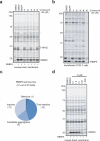Identification of selective inhibitors of uncharacterized enzymes by high-throughput screening with fluorescent activity-based probes
- PMID: 19329999
- PMCID: PMC2709489
- DOI: 10.1038/nbt.1531
Identification of selective inhibitors of uncharacterized enzymes by high-throughput screening with fluorescent activity-based probes
Erratum in
- Nat Biotechnol. 2009 May;27(5):485
Abstract
High-throughput screening to discover small-molecule modulators of enzymes typically relies on highly tailored substrate assays, which are not available for poorly characterized enzymes. Here we report a general, substrate-free method for identifying inhibitors of uncharacterized enzymes. The assay measures changes in the kinetics of covalent active-site labeling with broad-spectrum, fluorescent probes in the presence of inhibitors by monitoring the fluorescence polarization signal. We show that this technology is applicable to enzymes from at least two mechanistic classes, regardless of their degree of functional annotation, and can be coupled with secondary proteomic assays that use competitive activity-based profiling to rapidly determine the specificity of screening hits. Using this method, we identify the bioactive alkaloid emetine as a selective inhibitor of the uncharacterized cancer-associated hydrolase RBBP9. Furthermore, we show that the detoxification enzyme GSTO1, also implicated in cancer, is inhibited by several electrophilic compounds found in public libraries, some of which display high selectivity for this protein.
Figures






References
-
- Inglese J, et al. High-throughput screening assays for the identification of chemical probes. Nat Chem Biol. 2007;3:466–479. - PubMed
-
- Shelat AA, Guy RK. Scaffold composition and biological relevance of screening libraries. Nat Chem Biol. 2007;3:442–446. - PubMed
-
- Ahn K, et al. A novel mechanistic class of fatty acid amide hydrolase inhibitors with remarkable selectivity. Biochemistry. 2007;46:13019–13030. - PubMed
-
- Jo E, et al. S1P1-selective in vivo-active agonists from high-throughput screening: off-the-shelf chemical probes of receptor interactions, signaling, and fate. Chem Biol. 2005;12:703–715. - PubMed
-
- Dolma S, Lessnick SL, Hahn WC, Stockwell BR. Identification of genotype-selective antitumor agents using synthetic lethal chemical screening in engineered human tumor cells. Cancer Cell. 2003;3:285–296. - PubMed
Publication types
MeSH terms
Substances
Grants and funding
LinkOut - more resources
Full Text Sources
Other Literature Sources
Molecular Biology Databases
Miscellaneous

